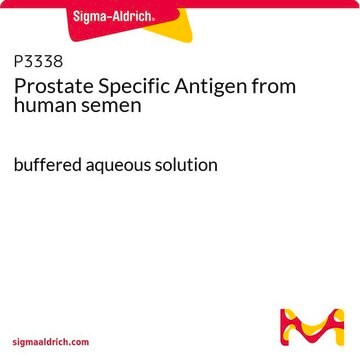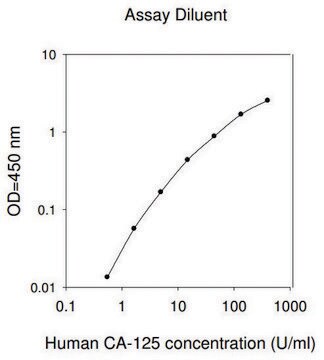C4835
Carcinoembryonic Antigen human
≥95% (SDS-PAGE), buffered aqueous solution
Synonym(s):
Cancer-associated CEA
Sign Into View Organizational & Contract Pricing
All Photos(1)
About This Item
Recommended Products
Quality Level
Assay
≥95% (SDS-PAGE)
form
buffered aqueous solution
UniProt accession no.
shipped in
dry ice
storage temp.
−20°C
Gene Information
human ... CEACAM5(1048)
General description
Carcinoembryonic antigen(CEA) or CEA cell adhesion molecule 5 (CEACAM5), is encoded by the gene mapped to human chromosome 19q13.2. CEACAM5 is a member of the CEACAM family. This glycosylated protein contains a typical N-terminal variable immunoglobulin (Ig)-like domain, constant Ig-like domain, and a hydrophobic transmembrane domain with a glycosylphosphatidylinositol lipid moiety.
Application
Carcinoembryonic Antigen human has been used as a standard in electrochemical immunosensor and developed surface plasmon resonance imaging (SPRi) immunosensor. It has also been used as a tumor-associated antigen (TAA) in enzyme-linked immunosorbent assay
Biochem/physiol Actions
Carcinoembryonic antigen cell adhesion molecule 5 (CEACAM5) aids in cell adhesion and migration. In addition, this protein inhibits anoikis and thereby promoting tumorigenesis and metastasis. CEACAM5 is used as a biomarker to detect new cancer and cancer recurrence, particularly those with colorectal cancer. Upregulated expression of the gene enhances non-small-cell lung cancer (NSCLC) cell proliferation and invasion by regulating p38–Smad2/3 signaling. Therefore, CEACAM5 might be considered as an effective therapeutic target for treating NSCLC. Overexpression of the gene has also been observed in various types of cancer including gastrointestinal, pancreatic, and breast cancers.
Packaging
Package size based on protein content
Quality
Highly purified
Physical form
Solution in 0.15 M phosphate buffered saline, pH 7.4, containing 0.1% sodium azide.
Storage Class Code
10 - Combustible liquids
WGK
WGK 1
Flash Point(F)
Not applicable
Flash Point(C)
Not applicable
Choose from one of the most recent versions:
Certificates of Analysis (COA)
Lot/Batch Number
Don't see the Right Version?
If you require a particular version, you can look up a specific certificate by the Lot or Batch number.
Already Own This Product?
Find documentation for the products that you have recently purchased in the Document Library.
Customers Also Viewed
Elrasheid A H Kheirelseid et al.
Journal of gastrointestinal oncology, 4(2), 144-157 (2013-06-05)
Despite developments in diagnosis and treatment, 20% of colorectal cancer (CRC) patients present with metastatic disease and 30% of cases recur after curative surgery. Furthermore, the molecular factors involved in prognosis and response to therapy in CRC is poorly understood.
Xinwen Zhang et al.
The Journal of international medical research, 48(9), 300060520959478-300060520959478 (2020-10-01)
To detect the expression of CEA-related cell adhesion molecule 5 (CEACAM5) in non-small-cell lung cancer (NSCLC) and explore its function in the progression and development of NSCLC. qRT-PCR and immunohistochemistry were performed to detect CEACAM5 expression in human NSCLC tissues
Go, V.L.W.
Cancer, 38, 562-562 (1976)
Beata Szymanska et al.
Analytical biochemistry, 609, 113964-113964 (2020-09-27)
Carcinoembryonic antigen (CEA) is one of the biomarkers most commonly used to determine tumor activity. In this work, a Surface Plasmon Resonance imaging (SPRi) immunosensor was developed. The immunosensor consists of a cysteamine linker attached to a gold chip and
Zeynep Altintas et al.
Talanta, 86, 377-383 (2011-11-09)
An immunoassay in optimised conditions with a highly sensitive surface plasmon resonance (SPR) based biosensor was developed for the detection of the cancer biomarker carcinoembryonic antigen (CEA). Different formats of the immunoassay were initially investigated on the surface of the
Our team of scientists has experience in all areas of research including Life Science, Material Science, Chemical Synthesis, Chromatography, Analytical and many others.
Contact Technical Service









